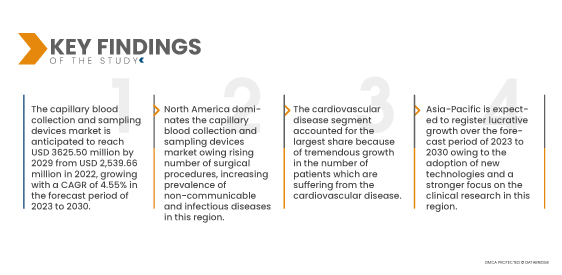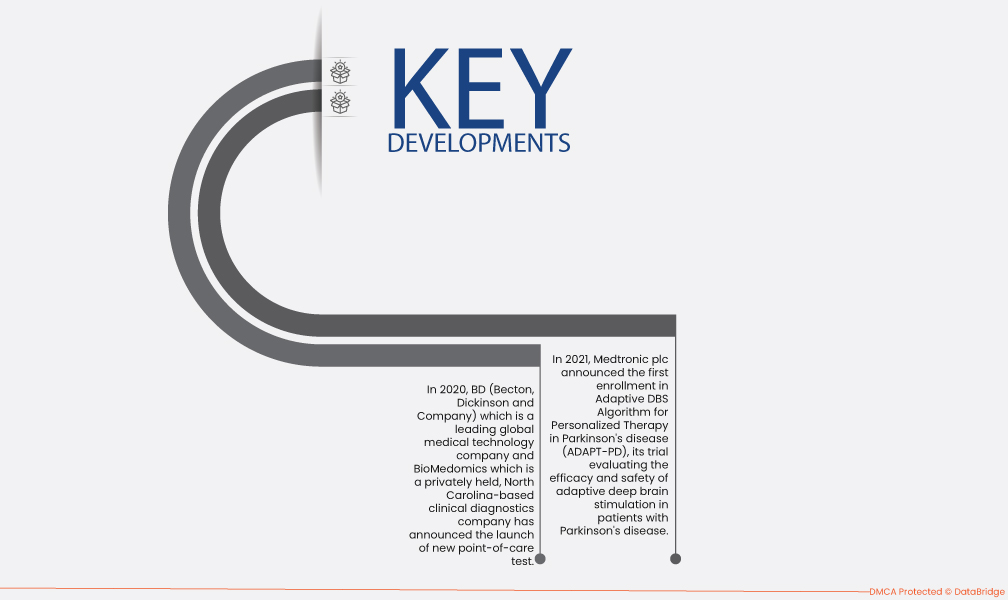Chronic diseases are a global healthcare problem. Unhealthy diet, physical inactivity, and change in lifestyle are increasing the burden of chronic diseases all around the globe. For instance, as per the data of centres for disease control and prevention, 6 out of 10 adults in the U.S. suffer from chronic disease. Therefore, the augmented prevalence of chronic and infectious diseases will likely boost market growth.
Data Bridge Market Research analyses that the Capillary Blood Collection and Sampling Devices Market expected to reach USD 3625.50 million by 2029 from USD 2,539.66 million in 2022, growing with a CAGR of 4.55% in the forecast period of 2023 to 2030.
The increasing availability of Point-of-care (POC) diagnostics is expected to drive the market's growth rate
Point-of-care testing diagnostics is becoming more popular due to its various benefits. Point-of-care testing is diagnostic testing done on patients' bedsides in the home. Furthermore, it can be performed at any location and at any time. As a result of this, it is generally referred to as bedside testing. Moreover, the demand for point-of-care testing has augmented due to increasing health awareness and the rising incidence of infectious diseases. Traditional arterial and venous blood collection methods are invasive and painful, with a higher risk of contamination and needle stick injuries if not performed by professionals. Therefore, increasing availability of point-of-care (POC) diagnostics is expected to increase the market's growth rate
Report Scope and Market Segmentation
|
Report Metric
|
Details
|
|
Forecast Period
|
2023 to 2030
|
|
Base Year
|
2022
|
|
Historic Years
|
2021 (Customizable to 2015- 2020)
|
|
Quantitative Units
|
Revenue in USD Million, Volumes in Units, Pricing in USD
|
|
Segments Covered
|
Product (Blood Sampling Devices, Capillary Blood Collection Devices, Rapid Test Cassette, Remote Capillary Blood Collection Device, Wearable Capillary Blood Collection Device), Modality (Manual Sampling, Automated/Autoinjection Sampling), Mode of Administration (Puncture, Incision), Application (Cardiovascular Disease, Infection and Infectious Disease, Respiratory Diseases, Cancers, Rheumatoid Arthritis, Others), Platform (Enzyme Immunoassay Platform (Elisa Platform), PCR Platform, Lateral Flow Immunoassay Platform, ELTABA Platform, Others), Procedure (Conventional, Point of Care Testing), Age Group (Geriatrics, Infant, Pediatric, Adult), Test Type (Whole Blood Test, Dried Blood Spot Tests, Plasma/Serum Protein Tests, Liver Panel/Liver Profile/Liver Function Tests, Comprehensive Metabolic Panel (CMP) Tests, Others), Technology (Volumetric Absorptive Microsampling, Capillary Electrophoresis-Based Chemical Analysis, Others), Material (Plastic, Glass, Stainless Steel, Ceramic), End User (Laboratories, Home Care Setting), Distribution Channel (Direct Tender, Retail Sales, Others)
|
|
Countries Covered
|
U.S., Canada and Mexico in North America, Germany, France, U.K., Netherlands, Switzerland, Belgium, Russia, Italy, Spain, Turkey, Rest of Europe in Europe, China, Japan, India, South Korea, Singapore, Malaysia, Australia, Thailand, Indonesia, Philippines, Rest of Asia-Pacific (APAC) in the Asia-Pacific (APAC), Saudi Arabia, U.A.E, South Africa, Egypt, Israel, Rest of Middle East and Africa (MEA) as a part of Middle East and Africa (MEA), Brazil, Argentina and Rest of South America as part of South America
|
|
Market Players Covered
|
B.D. (U.S.), Terumo BCT Inc. (U.S.), Fresenius KABI AG (Germany), Grifols S.A. (Spain), Nipro Medical Corporation (U.S.), Greiner AG (Austria), Quest Diagnostics Incorporated (U.S.), Mitra Industries Private Limited (India), SARSTEDT AG & Co. K.G. (Germany), CML Biotech (India), Macopharma (France), Neomedic Limited (U.S.), Haemonetics Corporation (U.S.), ICU Medical, Inc. (U.S.), SB-KAWASUMI LABORATORIES, INC. (Japan), Retractable Technologies Inc. (U.S.)
|
|
Data Points Covered in the Report
|
In addition to the insights on market scenarios such as market value, growth rate, segmentation, geographical coverage, and major players, the market reports curated by the Data Bridge Market Research also include depth expert analysis, patient epidemiology, pipeline analysis, pricing analysis, and regulatory framework.
|
Segment Analysis:
The capillary blood collection and sampling devices market is segmented on the basis of product, modality, mode of administration, application, platform, procedure, age group, test type, technology, material, end user, and distribution channel.
- On the basis of product, the market is segmented into blood sampling devices, capillary blood collection devices, rapid test cassette, remote capillary blood collection device, wearable capillary blood collection device.
The capillary blood collection devices segment of product segment is anticipated to dominate the capillary blood collection and sampling devices market
Capillary blood collection devices is expected to dominate the global capillary blood collection and sampling devices market with 50.17% market share because it offers a wide field of view with reduced lateral resolution and decreased line density at depth. Hence, it is used in a various applications including transvaginal and transrectal examinations, abdominal examinations as well as diagnostic imaging of organs.
- On the basis of modality, the market is segmented into manual sampling and automated/autoinjection sampling. Manual is expected to dominate the global capillary blood collection and sampling devices market with 79.98% market share owing to its superiority. This method is less time consuming than other method.
- On the basis of mode of administration, the market is segmented into puncture and incision. Puncture segment is expected to dominate the global capillary blood collection and sampling devices market with 62.63% market share due to decreases the risk of anaemia in patients by minimalizing the effects of reduced blood volume.
- On the basis of application, the market is segmented into cardiovascular disease, infection and infectious disease, respiratory diseases, cancers, rheumatoid arthritis, others. Cardiovascular disease segment is expected to dominate the global capillary blood collection and sampling devices market with 70.60% market share because tremendous growth in the number of patients which are suffering from the cardiovascular disease.
- On the basis of platform, the market is segmented into enzyme immunoassay platform (elisa platform), PCR platform, eltaba platform, lateral flow immunoassay platform and others.
The enzyme immunoassay platform (elisa platform) segment of platform segment is anticipated to dominate the capillary blood collection and sampling devices market
- Enzyme immunoassay platform (elisa platform) segment is expected to dominate the global capillary blood collection and sampling devices market with 46.95% market share berceuse ELISA tests are more accurate than other. They can be considered very specific, sensitive and favourably compared with other methods.
- On the basis of procedure, the market is segmented into conventional and point of care testing. Conventional segment is expected to dominate the global capillary blood collection and sampling devices market with 80.22% market share because most market players offer traditional means for capillary blood collection.
- On the basis of age group, the market is segmented into geriatrics, infant, pediatric, adult. Adult segment is expected to dominate the global capillary blood collection and sampling devices market with 62.58% market share where they have weakened immune systems and often have chronic disease, and for this diagnosis they refer to low blood pressure. However, issues related to physical disruption and rapid treatment are expected to hinder market growth during the forecast period.
- On the basis of test type, the market is segmented into dried blood spot tests, plasma/serum protein tests, comprehensive metabolic panel (CMP) tests, liver panel/liver profile/liver function tests, whole blood test, others. In 2020, Dried blood spot tests segment is expected to dominate the global capillary blood collection and sampling devices market with 62.07% market share because of their high morbidity and ability to diagnose numerous diseases. Blood tests are anticipated in the area where require HIV testing, hepatitis and other illnesses.
- On the basis of technology, the market is segmented into volumetric absorptive microsampling and others. Volumetric absorptive microsampling segment is expected to dominate the global capillary blood collection and sampling devices market with 56.89% market share because this volumetric absorptive microsampling is new method that enables one drop of blood to be drawn.
- On the basis of material, the market is segmented into plastic, glass, stainless steel, ceramic. Plastic segment is expected to dominate the global capillary blood collection and sampling devices market with 66.58% market share because they are inexpensive, simple and bio positive in the human body. In last few years, plastic has become gradually used for medical purposes.
- On the basis of end user, the market is segmented into laboratories and home care setting. Laboratories segment is expected to dominate the global capillary blood collection and sampling devices market with 80.23% market share because capillary blood sampling have been used all over the world due to the accessibility of care-based testing (POC) which is one of the fastest growing regions in medicine.
- On the basis of distribution channel, the market is segmented into direct tender, retail sales, others. Direct tender segment is expected to dominate the global capillary blood collection and sampling devices market with 76.88% market share Bessie it is the main source of procurement in hospitals. With the growing cost of healthcare, hospitals are highly focusing on better services for customers coupled with reducing the overall cost.
Major Players
Data Bridge Market Research recognizes the following companies as the major capillary blood collection and sampling devices market players in capillary blood collection and sampling devices market B.D. (U.S.), Terumo BCT Inc. (U.S.), Fresenius KABI AG (Germany), Grifols S.A. (Spain), Nipro Medical Corporation (U.S.), Greiner AG (Austria), Quest Diagnostics Incorporated (U.S.), Mitra Industries Private Limited (India), SARSTEDT AG & Co. K.G. (Germany), CML Biotech (India), Macopharma (France), Neomedic Limited (U.S.).
Market Development
- In 2020, BD (Becton, Dickinson and Company), a leading global medical technology company, and BioMedomics, a privately held, North Carolina-based clinical diagnostics company, announced the launch of new point-of-care test. This new point-of-care test can detect antibodies in blood to confirm past or current exposure to COVID-19 symptoms in about 15 minutes.
- In 2021, Medtronic plc announced the first enrolment in Adaptive DBS Algorithm for Personalized Therapy in Parkinson's disease (ADAPT-PD), its trial evaluating the efficacy and safety of adaptive deep brain stimulation in patients with Parkinson's disease. Adaptive deep brain stimulation is an investigational feature of the Percept™ PC device that could be allowed if approved.
Regional Analysis
Geographically, the countries covered in the capillary blood collection and sampling devices market report are U.S., Canada and Mexico in North America, Germany, France, U.K., Netherlands, Switzerland, Belgium, Russia, Italy, Spain, Turkey, Rest of Europe in Europe, China, Japan, India, South Korea, Singapore, Malaysia, Australia, Thailand, Indonesia, Philippines, Rest of Asia-Pacific (APAC) in the Asia-Pacific (APAC), Saudi Arabia, U.A.E, South Africa, Egypt, Israel, Rest of Middle East and Africa (MEA) as a part of Middle East and Africa (MEA), Brazil, Argentina and Rest of South America as part of South America.
As per Data Bridge Market Research analysis:
North America is the dominant region in capillary blood collection and sampling devices market during the forecast period 2023 to 2030
North America dominates the capillary blood collection and sampling devices market owing to the adoption of new technologies and a stronger focus on clinical research in this region. Furthermore, the rising number of surgical procedures, increasing prevalence of non-communicable and infectious diseases, and growing cases of accidents and trauma cases will further enhance the market growth in this region.
Asia-Pacific is estimated to be the fastest-growing region in capillary blood collection and sampling devices market the forecast period 2023 to 2030
Asia-Pacific is expected to grow during the forecast period of 2022 to 2029 owing to the growing chronic diseases and a greater focus on clinical research in this region. Additionally, the increasing geriatric population and disposable incomes will further boost the market growth in this region.
For more detailed information about capillary blood collection and sampling devices market report, click here – https://www.databridgemarketresearch.com/reports/global-capillary-blood-collection-and-sampling-devices-market












